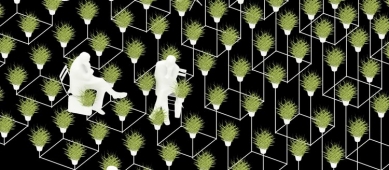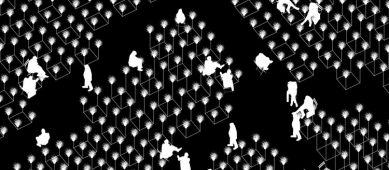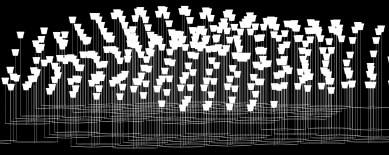
In the piazza of the National Theatre, a botanical labyrinth will grow
The installation Victoria pragensis investigates the role of greenery in public space.
Source
Protišedi.cz
Protišedi.cz
Publisher
Tisková zpráva
01.07.2017 10:35
Tisková zpráva
01.07.2017 10:35
Czech Republic
Prague
Nové Město
Juráš Lasovský
Lipinski Lasovsky Johansson
Piazzetta of the National Theatre will be dominated from Saturday, July 1, 2017, by the installation Victoria pragensis, a botanical labyrinth composed of nearly a thousand plants. Visitors will be able to find those that are used around the world as natural medicine due to their effects. The installation, authored by the Czech architect Juráš Lasovský, living in Copenhagen, will thus contrast the surrounding buildings with a temporary natural landscape, through which he aims to explore the role of greenery in public space. The event is held in cooperation with the National Theatre as part of the Piazetta24/7 project and will be on display until August 3, 2017.
The authors of the concept encourage the use of public spaces, which they perceive as part of our living rooms, working spaces, and places for relaxation. At the same time, they aim to emphasize the role of medicinal plants in the context of the urban environment and to spark a debate on how to preserve the valuable yet fragile historical legacy of natural medicine in the 21st century. Visitors will thus have the task of finding healing plants scattered throughout the length of the installation, which totals 936 plants built on a metal structure weighing 1.6 tons.
Juráš Lasovský, the author of the installation concept: “The demands on the city are changing. Its inhabitants increasingly perceive it as their own space, which is part of their homes and where they spend a lot of time. Awareness of the importance of plants for humans and for the city is growing. At the same time, the significance of greenery, urban parks, and community gardens creating urban microclimates is increasing. Greenery is perceived as an indicator of the quality of the city and often has a significant influence on the choice of locations for living, working, and leisure.”
The name Victoria pragensis refers to the discovery of the largest water lily in the world, Victoria amazonica, made by the Czech botanist Tadeáš Haenke in 1801. He was also one of the first to scientifically describe the exotic flora of Latin America. His name served as inspiration for the Hænke Botanical Lab, based in Prague's Žižkov. This lab focuses on educating about medicinal plants and researching interactions between humans and nature.
The vernissage of the installation will take place on Saturday, July 1, 2017, at 7:00 PM. The musical program will be provided by Vážný zájem; violinist Filip Zaykov and cellist Vilém Petras will perform. Throughout the duration of the installation, there will be accompanying programs: guided tours, workshops, and other events.
The event is under the patronage of Eliška Kaplický Fuchsová, Chairwoman of the Committee for Culture, Heritage Care, Exhibitions, Tourism, and Foreign Relations of the City of Prague. The event is held with the kind support of the Prague 1 Municipality.
More information >
The authors of the concept encourage the use of public spaces, which they perceive as part of our living rooms, working spaces, and places for relaxation. At the same time, they aim to emphasize the role of medicinal plants in the context of the urban environment and to spark a debate on how to preserve the valuable yet fragile historical legacy of natural medicine in the 21st century. Visitors will thus have the task of finding healing plants scattered throughout the length of the installation, which totals 936 plants built on a metal structure weighing 1.6 tons.
Juráš Lasovský, the author of the installation concept: “The demands on the city are changing. Its inhabitants increasingly perceive it as their own space, which is part of their homes and where they spend a lot of time. Awareness of the importance of plants for humans and for the city is growing. At the same time, the significance of greenery, urban parks, and community gardens creating urban microclimates is increasing. Greenery is perceived as an indicator of the quality of the city and often has a significant influence on the choice of locations for living, working, and leisure.”
The name Victoria pragensis refers to the discovery of the largest water lily in the world, Victoria amazonica, made by the Czech botanist Tadeáš Haenke in 1801. He was also one of the first to scientifically describe the exotic flora of Latin America. His name served as inspiration for the Hænke Botanical Lab, based in Prague's Žižkov. This lab focuses on educating about medicinal plants and researching interactions between humans and nature.
The vernissage of the installation will take place on Saturday, July 1, 2017, at 7:00 PM. The musical program will be provided by Vážný zájem; violinist Filip Zaykov and cellist Vilém Petras will perform. Throughout the duration of the installation, there will be accompanying programs: guided tours, workshops, and other events.
The event is under the patronage of Eliška Kaplický Fuchsová, Chairwoman of the Committee for Culture, Heritage Care, Exhibitions, Tourism, and Foreign Relations of the City of Prague. The event is held with the kind support of the Prague 1 Municipality.
More information >
The English translation is powered by AI tool. Switch to Czech to view the original text source.





0 comments
add comment










